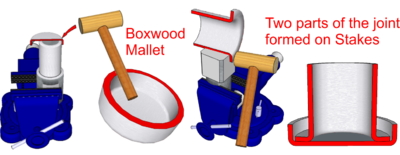Knocked Up Joint: Difference between revisions
From DT Online
(Created article) |
mNo edit summary |
||
| Line 8: | Line 8: | ||
=====Description===== | =====Description===== | ||
A '''Knocked Up Joint''' or [https://en.wikipedia.org/wiki/Hemming_and_seaming '''Double Seam'''] is commonly used to fix an end to a cannister or food can. The canning industry would normally use a '''Seaming Machine''' ''(see [http://adashofscience.com/ | A '''Knocked Up Joint''' or [https://en.wikipedia.org/wiki/Hemming_and_seaming '''Double Seam'''] is commonly used to fix an end to a cannister or food can. The canning industry would normally use a '''Seaming Machine''' ''(see [http://adashofscience.com/category/science/engineering/ '''A Dash of Science'''] for further detail)'' but they were traditionally hand made by [https://en.wikipedia.org/wiki/Tinsmith '''Tinsmiths''']. If made properly a '''Knocked Up Joint''' should be water-tight without being soldered but, of course, they can be soldered as well if required. | ||
Latest revision as of 09:11, 28 February 2018
Description
A Knocked Up Joint or Double Seam is commonly used to fix an end to a cannister or food can. The canning industry would normally use a Seaming Machine (see A Dash of Science for further detail) but they were traditionally hand made by Tinsmiths. If made properly a Knocked Up Joint should be water-tight without being soldered but, of course, they can be soldered as well if required.
Making the Joint
- To make the base, mark out a circle with its radius equal to the cylinder radius plus twice the width of the Seam.
- Form a rim round its outside with a depth equal to the width of the Seam (do this by working around the circumference little by little with Flat Nosed Pliers and truing up with a Boxwood or Rawhide Mallet on a Mandrel Stake).
- The length of the cannister needs to be extended by the width of the Seam so that a flange equal to this can be formed around one end (as before, do this by working around the end little by little with Flat Nosed Pliers and truing up with a Boxwood or Rawhide Mallet on a Bench Block, Tinman's Anvil or similar flat surface).
- Place the flanged cannister inside the rim of the base and flatten the rim down on to it using a Boxwood or Rawhide Mallet down on to a Bench Block or similar surface.
- The joint formed at this stage is known as a Paned Down Seam
- To complete the Knocked Up Joint or Double Seam, the cannister is held on to a Mandrel Stake and folded over again as shown.
Note: Use a Mallet and not a Hammer to avoid stretching the metal as it is struck (this would cause the edge to distort).

















